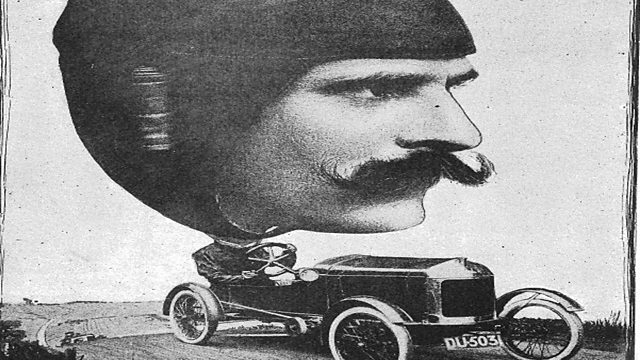Spon Street, Coventry: The Toughest Bullet of the War
The Buckingham incendiary bullet that damaged the buoyant German Zeppelins
James Buckingham was a motor engineer and racing car driver in 1914 in Coventry. His workshop was at 159 Spon Street. During the war he became the inventor of a revolutionary bullet during the Great War.
Damien Kimberley from Coventry Museums explains who James Buckingham was:
“He made the Top Gear’s affordable car of the era; a light car. His most famous was the ‘Chota’; he also had one called the Buckingham Palace. The ‘Chota’ was allegedly so loud it blew windows out in Coventry. He used to race them too, winning multiple championships. He became something of a celebrity of his day; the picture featured is from the Light Car and Cycle magazine in 1914.”
The war had begun and Great Britain was under threat. The navy had always defended Great Britain but for the first time, the attacks came from the air. Zeppelins were huge airships originally invented to revolutionise world travel but brought the war to our doorstep.
Planes were still in their early infancy, built from wood and wires. The BE2C was manufactured by Daimler, in Radford as Barry James from the Midland Air Museum describes:
“This plane came about to take on the Zeppelins, and reach their altitudes of around 15,000 feet. These bi-planes struggled to get up to those altitudes quickly; they were open to the elements; the higher they went the more they struggled with oxygen levels.
Zeppelins damage was limited but the terror effect was huge. Questions were asked in the Houses of Parliament as to how the country was to fight against the Zeppelins. Ordinary bullets passed straight through the gas pockets which kept it afloat, the biggest challenge was trying to get the hydrogen gas to explode.”
One man who was busy working to solve that problem was James Buckingham. Meanwhile in Germany, the Zeppelins were causing an altogether different problem. Dr Catherine Zentile has researched the creation of the Zeppelins:
“In each fabric, if you think about trying to contain a gas, especially one as small as hydrogen, the molecules seep through the weave, so they needed a material that was incredibly gas tight and they found the solution in cow's intestines. Each gas bag, you needed 15 animals’ intestines to make 1sqm, and so for one Zeppelin you had a minimum of 300,000 animals that are being used to create the gas bags!
“Before the war, sausages were the staple diet; every one of these intestines would have been used to make salamis and so on. The Germans are famous for their sausages. As part of your patriotism, you’d have given up your bratwurst to make a Zeppelin.”
James Buckingham had studied chemistry before he started making cars, which may explain how he was able to invent an exploding bullet using phosphorous.
Hydrogen gas is explosive, but in the case of the Zeppelins was only used for buoyancy, not propulsion. Phosphorous spontaneously combusts when mixed with oxygen.
Dr Hugh Hunt is from Trinity College, Cambridge, and features in Channel 4’s Dambusters and Escape from Colditz. As he was making a programme called Attack of the Zeppelins; exploring how the British fighter pilots used incendiary bullets, he realised he had a closer connection to the story:
“About half way through the filming, my cousin said ‘oh you’ll be talking about Great Uncle Jim’. It turned out my Great Uncle Jim had invented an incendiary bullet. It took a couple of years to work out the best combination of bullets to shoot down the Zeppelins. It is interesting to think that the Tracer Bullets are thought of as a WW2 item but it is the same as an incendiary bullet and in fact the same technology/theory is still used today. He was a prolific car inventor, but along came the First World War and he suddenly stopped making cars but then started making bullets, over 26 million were used during the First World War.
It is sad that we lose the connection to our ancestors and when we want to find out about them it is usually too late to ask the people who knew.”
The Zeppelin raids petered out during the war as Britain’s ability to fight back improved. There was a saying: to have given them ‘a round of Buckinghams’.
After the war Buckingham was awarded an OBE and £10,000. He moved out of Coventry to Offchurch and the business was moved to Kenilworth. It was later bought by Eagle Engineering.
Buckinghams of Kenilworth Ltd on Dalehouse Lane is a derivative of James Buckingham’s company. They manufacture pools and tankers.
Location: 159 Spon Street, Coventry CV1 3BB
Image shows James Buckingham on the front cover of Light and Cycle Car magazine (1914)
Presented by Siobhan Harris
Duration:
This clip is from
Featured in...
![]()
Innovations—World War One At Home
Where war was the mother of invention
![]()
����ý Coventry & Warwickshire—World War One At Home
Places in Coventry & Warwickshire that tell a story of World War One
More clips from World War One At Home
-
![]()
The loss of HMY Iolaire
Duration: 18:52
-
![]()
Scotland, Slamannan and the Argylls
Duration: 07:55
-
![]()
Scotland Museum of Edinburgh mourning dress
Duration: 06:17
-
![]()
Scotland Montrose 'GI Brides'
Duration: 06:41







